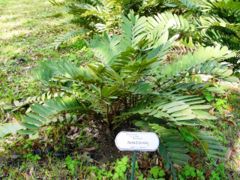Zamia
Zamia {{{latin_name}}}
|
'
| ||||||||||||||||||||||||||||||||||||||||
|---|---|---|---|---|---|---|---|---|---|---|---|---|---|---|---|---|---|---|---|---|---|---|---|---|---|---|---|---|---|---|---|---|---|---|---|---|---|---|---|---|---|

|
|
| |||||||||||||||||||||||||||||||||||||||
| |||||||||||||||||||||||||||||||||||||||||
Largest genus of cycad family, Zamiaceae, with over 55 species. Leaves are pinnate, stems are cylindrical or tuber-like. Stems usually subterranean but can be above ground. Palm or fern-like appearance, with male and female plants. Both sexes bear cones, those of the female being larger. Seeds of some species are highly toxic. Leaves are arranged like spirals, are arching, and have smooth leaflets for the most part, whose margins may be toothed, smooth-edged, or bumpy, and in some species spiny. Zamia originate from a range of habitats. Most do best tropical and subtropical frost-free regions, and make nice landscape plants.
Cultivation
| Zamia calendar? | ||
|---|---|---|
| January: | ||
| February: | ||
| March: | ||
| April: | ||
| May: | ||
| June: | ||
| July: | ||
| August: | ||
| September: | ||
| October: | ||
| November: | ||
| December: | ||
| Notes: | ||
Can grow in most well-drained soils. The open-habit types with tougher leaves can handle more exposure and more direct sun, while those with softer leaves, lusher growth, of the the understory types are better off with sheltered, semi-shaded placement and higher humidity.
Propagation
Propagation from fresh seed.
Pests and diseases
- Do you have pest and disease info on this plant? Edit this section!
Species
Partial list:
- Zamia acuminata
- Zamia boliviana
- Zamia encephalartoides
- Zamia fairchildiana
- Zamia fischeri
- Zamia furfuracea, Cardboard Zamia
- Zamia gateley scrabulous
- Zamia hymenophyllidia
- Zamia integrifolia, Florida Coontie, Florida Arrowroot (also Z. floridana)
- Zamia ipetiensis
- Zamia loddigesii
- Zamia montana
- Zamia polymorpha
- Zamia portoricensis
- Zamia pumila, Dominican Zamia
- Zamia roezlii
- Zamia skinneri
- Zamia vazquezii, Dwarf Mexican Zamia
- Zamia verschaffeltii
- Zamia wallisii
Gallery
If you have a photo of this plant, please upload it! Plus, there may be other photos available for you to add.
-
photo 1
-
photo 2
-
photo 3
References
- Flora: The Gardener's Bible, by Sean Hogan. Global Book Publishing, 2003. ISBN 0881925381
